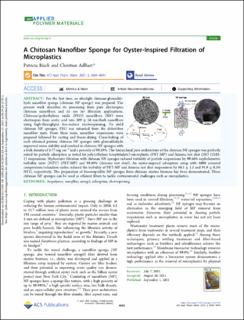Please use this identifier to cite or link to this item:
https://doi.org/10.21256/zhaw-23136| Publication type: | Article in scientific journal |
| Type of review: | Peer review (publication) |
| Title: | A chitosan nanofiber sponge for oyster-inspired filtration of microplastics |
| Authors: | Risch, Patricia Adlhart, Christian |
| et. al: | No |
| DOI: | 10.1021/acsapm.1c00799 10.21256/zhaw-23136 |
| Published in: | ACS Applied Polymer Materials |
| Volume(Issue): | 3 |
| Issue: | 9 |
| Page(s): | 4685 |
| Pages to: | 4694 |
| Issue Date: | 2021 |
| Publisher / Ed. Institution: | American Chemical Society |
| ISSN: | 2637-6105 |
| Language: | English |
| Subjects: | Biopolymer; Nanofiber; Aerogel; Adsorption; Electrospinning |
| Subject (DDC): | 572: Biochemistry |
| Abstract: | For the first time, an ultralight chitosan-glutaraldehyde nanofiber sponge (chitosan NF sponge) was prepared. The present work describes its processing from pure electrospun chitosan nanofibers and its use for filtration applications. Chitosan/polyethylene oxide (PEO) nanofibers (NF) were electrospun from acetic acid into 309 ± 56 nm-thick nanofibers using high-throughput free-surface electrospinning. To yield chitosan NF sponges, PEO was extracted from the defect-free nanofiber mats. From these mats, nanofiber suspensions were prepared followed by casting and freeze-drying. Cross-linking of such obtained pristine chitosan NF sponges with glutaraldehyde improved water stability and resulted in chitosan NF sponges with a bulk density of 5.77 mg cm–3 and a porosity of 99.59%. The hierarchical pore architecture of the chitosan NF sponges was perfectly suited for particle adsorption as tested for poly(ethylene terephthalate)-microplastic (PET-MP) and Arizona test dust (ISO 12103-1) suspensions. Hydrostatic filtration with chitosan NF sponges reduced turbidity of particle suspensions by 99.46% nephelometric turbidity units (NTU) (PET-MP) and 99.49% (Arizona test dust). An oyster-inspired adsorption setup with 4000 actuated compression/relaxation cycles reduced the turbidity of PET-MP and Arizona test dust suspensions by 80.1 ± 1.5 and 91.9 ± 0.3% NTU, respectively. The preparation of biocompatible NF sponges from chitosan marine biomass has been demonstrated. These chitosan NF sponges can be used as efficient filters to tackle environmental challenges such as microplastics. |
| URI: | https://digitalcollection.zhaw.ch/handle/11475/23136 |
| Fulltext version: | Published version |
| License (according to publishing contract): | CC BY-NC-ND 4.0: Attribution - Non commercial - No derivatives 4.0 International |
| Restricted until: | 2022-09-02 |
| Departement: | Life Sciences and Facility Management |
| Organisational Unit: | Institute of Chemistry and Biotechnology (ICBT) |
| Published as part of the ZHAW project: | BIOMAT (Integrated Bio-based Materials Value Chains) |
| Appears in collections: | Publikationen Life Sciences und Facility Management |
Files in This Item:
| File | Description | Size | Format | |
|---|---|---|---|---|
| 2021_Risch-Adlhart_A-chitosan-nanofiber-sponge-for-oyster-inspired-filtration-of-microplastics.pdf | 5.76 MB | Adobe PDF |  View/Open |
Show full item record
Risch, P., & Adlhart, C. (2021). A chitosan nanofiber sponge for oyster-inspired filtration of microplastics. ACS Applied Polymer Materials, 3(9), 4685–4694. https://doi.org/10.1021/acsapm.1c00799
Risch, P. and Adlhart, C. (2021) ‘A chitosan nanofiber sponge for oyster-inspired filtration of microplastics’, ACS Applied Polymer Materials, 3(9), pp. 4685–4694. Available at: https://doi.org/10.1021/acsapm.1c00799.
P. Risch and C. Adlhart, “A chitosan nanofiber sponge for oyster-inspired filtration of microplastics,” ACS Applied Polymer Materials, vol. 3, no. 9, pp. 4685–4694, 2021, doi: 10.1021/acsapm.1c00799.
RISCH, Patricia und Christian ADLHART, 2021. A chitosan nanofiber sponge for oyster-inspired filtration of microplastics. ACS Applied Polymer Materials. 2021. Bd. 3, Nr. 9, S. 4685–4694. DOI 10.1021/acsapm.1c00799
Risch, Patricia, and Christian Adlhart. 2021. “A Chitosan Nanofiber Sponge for Oyster-Inspired Filtration of Microplastics.” ACS Applied Polymer Materials 3 (9): 4685–94. https://doi.org/10.1021/acsapm.1c00799.
Risch, Patricia, and Christian Adlhart. “A Chitosan Nanofiber Sponge for Oyster-Inspired Filtration of Microplastics.” ACS Applied Polymer Materials, vol. 3, no. 9, 2021, pp. 4685–94, https://doi.org/10.1021/acsapm.1c00799.
Items in DSpace are protected by copyright, with all rights reserved, unless otherwise indicated.